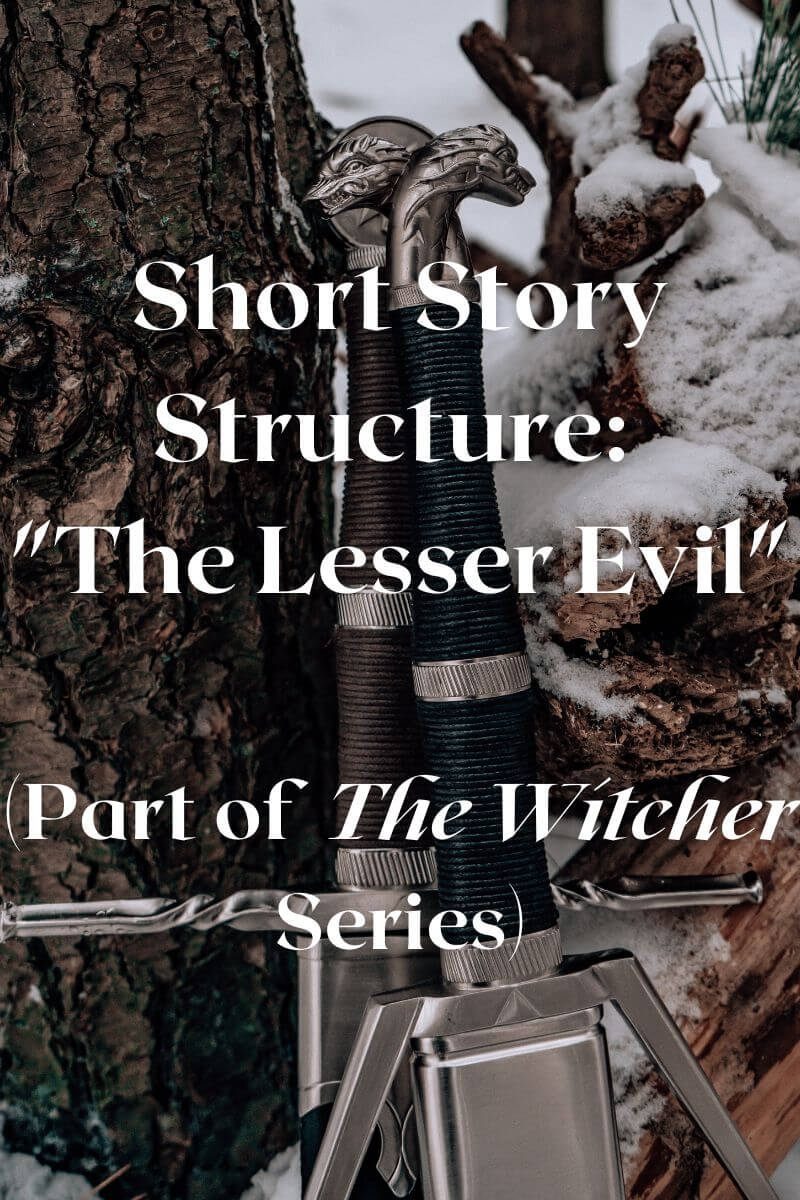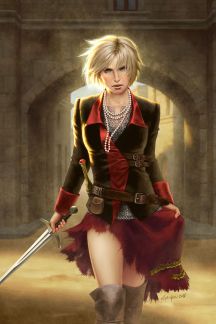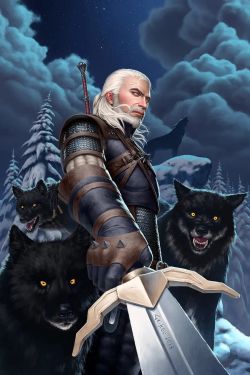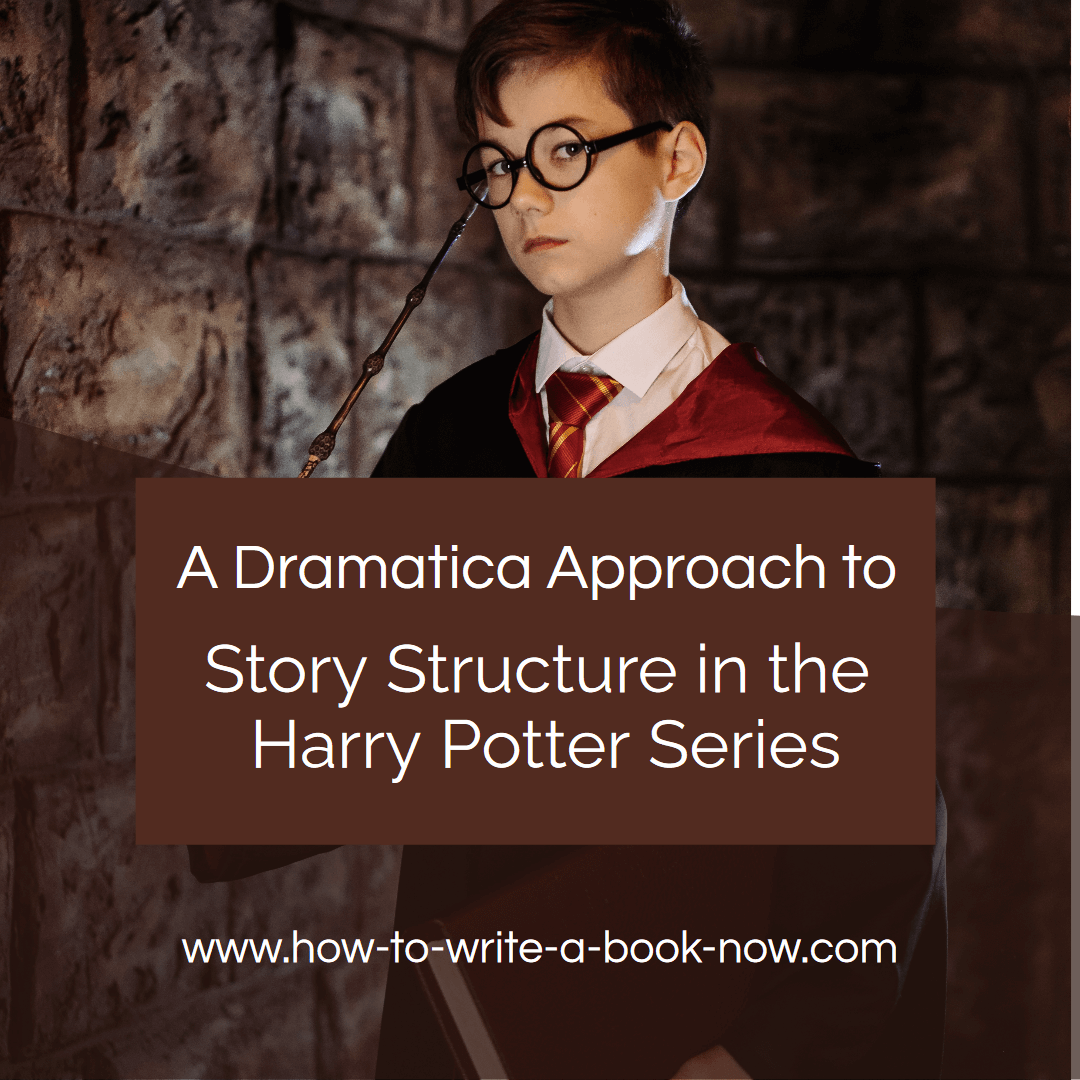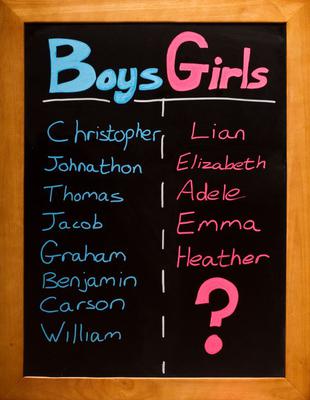Structuring
the Short Story:
Andrzej Sapkowski's “The Lesser Evil”
By Glen C. Strathy
The principles of story structure are the same whether you are writing a full-length work or short fiction. Writing short short stories or even flash fiction can be a good way for aspiring writers to develop their sense of structure, as well as other fiction writing skills, before tackling a longer, more complex work such as a novel. If you are writing speculative fiction or any series of stories set in the same story world, you can introduce parts of that world in a number of short stories before writing a novel in the same world – an approach that makes the best use of the effort you spend researching and designing your story world. That was the approach Andrzej Sapkowski took when writing “The Lesser Evil” and other short stories that belong to his most famous fantasy series, The Witcher, which I have recently (and belatedly) begun exploring.
“The Lesser Evil” appears in Sapkowski's anthology, The Last Wish, which is one of eight books that are part of The Witcher series. In 2019, the story was made into an episode of The Witcher television series that appeared on Netflix.
The Witcher series falls within the fantasy subgenre of Sword & Sorcery, which are fantasy adventure stories set in fictional worlds that resemble Europe before the invention of firearms (hence, the use of swords) and also feature magic and magical creatures. Sword & Sorcery differs from high fantasy stories like The Lord of the Rings in that it generally involves more low-life characters with less than noble aims.
The main character of The Witcher series is Geralt of Rivia, who is a witcher by profession. Witchers are freelance monster killers and curse breakers who have received special training, tools, and bodily mutations necessary to perform their highly dangerous work. “The Lesser Evil” plays a foundational role in The Witcher series, exploring Geralt's personal moral code and explaining why his life as a witcher tends to be a solitary existence.
Let's start with the basic structure of the story. As usual, I will look at it mostly through the eyes of Dramatica.
The Four Act Structure of "The Lesser Evil"
By definition, a well structured story is told in four parts or acts that unfold in a particular chronological order:
setup → complication → crisis → resolution
(Some writers describe story structure using a three-act model, but in a three-act model the middle act is really a combination of the complication and crisis parts, which is why it is always the longest act. So really they are describing the same structure, just looking at it in a different way.)
The four acts of “The Lesser Evil” unfold as follows:
Act One: Setup
Geralt arrives in the town of Blaviken the day before market day, looking to make some money by selling the carcass of a monster he has just killed. Unfortunately, the town Alderman can't pay him anything, but it occurs to them that the town wizard might. So Geralt visits the wizard, Stregobor, at his tower. Stregobor isn't interested in Geralt's monster, but wants Geralt's help with an urgent matter. Stregobor has an enemy who has also just arrived in Blaviken, a young woman named Renfri. Renfri is inspired by the fairytale character, Snow White. She had been born a princess, but, at her stepmother's request, Stregobor identified her as a monster – one of a number of princesses who were born shortly after an eclipse known as “The Black Sun.” Allegedly, these princesses possessed mutations that made them so predisposed to violence that they represented a serious threat. Renfri is the last survivor of the group, the rest of whom were killed or imprisoned by wizards, supposedly to protect the world from them. When Renfri was a child, Stregobor and the stepmother tried to have Renfri killed, but she escaped, eventually became an outlaw, and is now determined to kill Stregobor in revenge for how he ruined her life.
Stregobor is safe inside his tower, but cannot leave because he knows Renfri will try to kill him. He can't defend himself in a confrontation with Renfri because she has become resistant to magic (a possible side effect of mutation). So he offers to pay Geralt to kill Renfri for him, claiming it is "the lesser evil.” Geralt is unconvinced by Stregobor's description of Renfri as a monster. The evidence is flimsy at best. More importantly, while witchers kill monsters for money, Geralt draws the line at killing people. Since Stegobor seems safe for the time being, Geralt sets out to find a non-violent solution to the problem.
Act Two: Complication
Geralt and the Alderman meet with Renfri and her crew of assassins. Unfortunately, the Alderman cannot simply jail Renfri "preventatively" because it turns out she has a letter of protection from the king.
Renfri meets Geralt in private and tells him her version of her life story, emphasizing the poverty and abuse she endured after Stregobor and her stepmother tried to have her killed and she was left to fend for herself in the world. Renfri claims Stregobor is the monster, and offers to pay Geralt to kill him, arguing that it would be "the lesser evil.”
Geralt refuses Renfri's offer, just as he did Stregobor's, and for similar reasons. Instead, he tries to convince Renfri to give up her desire for revenge. He even tries to hypnotize her using a magic amulet, which seems to work. Renfri promises to leave town without killing Stregobor and initiates a sexual tryst with Geralt.
Act Three: Movement toward Crisis
The next morning, Geralt receives some information from the Alderman that makes him realize Renfri lied about leaving town. Renfri has had a plan all along to end the standoff using a tactic called “the Tridam ultimatum.” Her men will seize hostages at the crowded market and kill them one by one until Stregobor leaves his tower, at which point Renfri can take her revenge on him. Due to the King's letter, the Alderman is powerless to intervene until a crime has been committed – at which point it will be too late to prevent a mass murder. Geralt realizes he must stop Renfri's men before the market opens.
Act 4: Movement toward Resolution
Geralt kills Renfri's men in the marketplace. Stregobor watches the men die in his crystal ball, so when Renfri arrives at his door with her ultimatum, he is able to call her bluff. Renfri goes to the market and attacks Geralt to avenge her men, and Geralt is forced to kill her as well. Though Geralt acted to protect the townsfolk, they do not understand his motives nor how Renfri had planned to use them as hostages. All they know is that Geralt committed a mass murder. They pelt him with stones and the Alderman demands he leave town forever.
Okay, that's the basic four-part structure. Now let's go a step deeper.
Key Turning Points in "The Lesser Evil"
In a well-structured story, each of the four acts begins and ends with a major turning point. Dramatica calls these turning points “drivers,” because they send the story in a new direction, all except the last one, of course which creates a new stability in the story world, bringing the plot to an end.
You can think of the five drivers as follows:
Initial Driver: Sometimes called the “inciting incident,” this event disrupts the stability of the story world, usually by creating a new threat or opportunity that triggers the chain of events that make up the plot.
Second Driver: An event that causes the plot to “thicken” or become more serious.
Third Driver: An event that triggers a more intense build toward the crisis.
Crisis Driver: This is the major turning point in the story. If disaster seems inevitable at this point, the situation will reverse here, leading to a happy ending. If the hero seems likely to succeed at this point, his fortune will reverse, leading to a tragedy.
Final Driver: This event determines decisively whether the story will end happily or unhappily.
In “The Lesser Evil,” the five drivers are all decisions made by Geralt that change the direction and outcome of the story:
Initial Driver: The plot begins when Geralt decides to visit Stregobor. This opens up a new possibility, that Stregobor (or possibly Renfri) could hire Geralt to resolve the problem between them.
Second Driver: Geralt rejects Stegobor's offer and instead decides to look for a non-violent solution.
Third Driver: Geralt accepts Renfri's insincere promise to leave town without getting revenge. (With Geralt assauged, nothing stands in the way of Renfri carrying out her plan.)
Crisis Driver: Geralt realizes Renfri lied and decides he must intervene to stop her men from massacring people in the market.
Final Driver: Geralt refuses to allow Stregobor to perform an autopsy on Renfri after she has died. This decision marks an end to the abuse Stregobor and other wizards inflicted on the princesses born under the Black Sun.
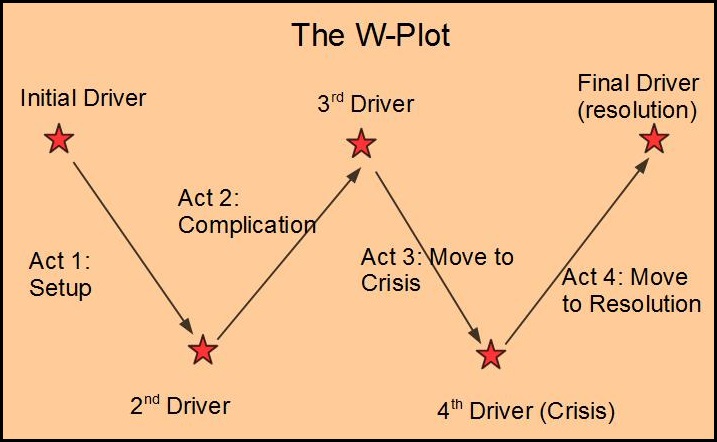 Chronological arrangement of acts and drivers in a story.
Chronological arrangement of acts and drivers in a story.The Main Character's Arc
In addition to the overall plot described above, stories have greater emotional impact when the main character is given an inner conflict that develops and is resolved over the course of events. Often, the main character must wrestle with the decision whether to follow his initial or preferred approach to solving problems, or heed the advice and example of another character who champions a different approach. Dramatica calls this other character the “impact” or “influence” character. Sometimes the impact character is the villain, but often another character will perform this function.
The main character's inner conflict generally unfolds in a four-part pattern much like the overall story.
1. Initial Approach: The main character's preferred approach is contrasted with that of the impact character.
2. Growth: The main character feels pressure to abandon his initial approach and instead switch to the impact character's approach.
3. Personal crisis: the turning point when the main character chooses whether to take a leap of faith and change, or double down on his tried and true approach.
4. Judgement: An illustration of whether the main character is left in a better or worse place as a result of the choice he made at his personal crisis.
In “The Lesser Evil,” Geralt's inner conflict revolves around his personal moral code. As a professional killer, he is often in situations where he must choose whether an alleged monster will live or die. At times, he may find it tempting to “choose the lesser evil,” which is still evil, rather than put in the effort to find a truly good resolution to a situation. So it is not surprising that, at the start of “The Lesser Evil,” Geralt has established a personal moral code, which he explains to Stregobor at their first meeting:
"'Evil is evil,' said the witcher seriously as he got up. 'Lesser, middling, greater, it's all the same... I'm not a pious hermit. I haven't done only good in my life. But if I'm to choose between one evil and another, then I prefer not to choose at all.'"
Renfri is the impact character in the story, as well as the protagonist pursuing the goal of revenge (while Geralt is the main character and also the antagonist attempting to stop her). As the impact character, Renfri throws doubt onto Geralt's convictions, pressuring him to see “choosing the lesser evil” as a more valid approach to solving problems. She does this first through the example of her personal history. Renfri tells Geralt how, after surviving the assassination attempt as a child, she was forced to do many evil deeds to survive. Time and again she chose what she saw as the lesser evil – even when it involved murder. She also warns Geralt explicitly that one cannot always avoid doing evil:
“True Evil, Geralt, is something you can barely imagine, even if you believe nothing can still surprise you. And sometimes True Evil seizes you by the throat and demands that you choose between it and another, slightly lesser, Evil.”
With Geralt's central dilemma established, the reader wonders whether Geralt will stick with his initial approach or change and adopt Renfri's approach. We see him reject Stregobor's request that he kill Renfri, which the wizard claims is the lesser evil. We see him reject Renfri's request that he kill Stregobor, which she claims would be the lesser evil. But Geralt's personal crisis arises when he realizes he is the only person who can intervene to stop Renfri's planned masacre. At that moment, he abandons his personal code and tells the Alderman, “We have to take the lesser evil!”, before grabbing his sword and heading to the marketplace.
Unfortunately, because Geralt avoided picking sides earlier (which might have meant killing one person), he is now in the position of having to kill Renfri and all of her men
to prevent them from killing others. He missed his chance to pick "the lesser evil."
Very often, if the main character resolves his personal crisis by changing, switching to the impact character's approach, then the impact character will not change. Indeed, Renfri rebuffs Geralt's efforts to persuade her to renounce violence (evil) as a solution to her problems. Even after her men are dead, when the surest way to guarantee her own survival might be to flee Blaviken, Renfi chooses to stay and attack Geralt, knowing the outcome will likely be her death. She states, “I can't do anything else. I just can't.”
At the end of the story, though he saved the townsfolk, Geralt's decision to choose the lesser evil fails to resolve his inner conflict in a way that leaves him happier or better off. Earlier in the story, Renfri predicts Geralt's fate: “You claim a lesser evil doesn't exist. You're standing on a flagstone, running with blood, alone and so very lonely because you can't choose, but you had to. And you'll never know, you'll never be sure, if you were right.”
Later, Renfri's words are echoed by Stregobor. When Geralt prevents the wizard from conducting an autopsy on Renfri, Stregobor replies, “As you wish! But you'll never know! You'll never be sure! Never, do you hear, witcher?”
Though Geralt doesn't understand why he prevents the autopsy (he acts on a sudden impulse), it may be that he subconsciously didn't want to risk discovering that Renfri wasn't a monster after all. For, if that were true, Geralt would have to live with the knowledge that he committed evil. He is only supposed to kill monsters, but instead killed people. On the other hand, if the autopsy revealed Renfri was a monster, a mutation created by the Black Sun, then Geralt would have to live with the fact that, had he simply killed Renfri earlier at Stegobor's request, he might have avoided killing all the others in the marketplace and not done evil at all. The compassion he showed Renfri would have been a mistake. Either way, he would know that he broke his code. So this last driver shows Geralt already starting to backslide -- moving back toward his original stance of refusing to choose between two evils. By choosing not to know, Geralt retains the possibility that he made the right choice.
Having a main character backslide is a good technique when you are writing a series, because it means the character remains fundamentally the same at the start of the next story. Readers who like the character and want to read more of his adventures can move on to the other stories in the series, knowing they will be spending time with the same character, not a changed version of him. Often in series, the main character will not undergo a permanent change in his personality until the final book.
As a final piece of character illustration, Geralt is left alone at the end of the story, something Renfri predicted. He is banished from Blaviken, having earned the enmity of the Alderman and the townsfolk. His relationship with Renfri has been sacrificed. The only person who remains somewhat friendly to him is Stregobor, who may in fact be the real monster of the tale. Thus, "The Lesser Evil" establishes Geralt as a character who, though often called upon to help people threatened by monsters, seldom feels embraced by those he serves. Like Renfri, he is often suspected of being a monster himself.
Other Plot Elements in "The Lesser Evil"
In addition to the basic plot structure outlined above, there are other elements typically found in a solid plot. With some of these, it doesn't matter what order they appear chronologically, as long as they are illustrated somewhere in the story. For those who are interested in story theory, here's how some of them appear in “The Lesser Evil”:
Goal: The objective that involves or affects most of the characters in the story.
In
“The Lesser Evil,” the central driving force is Renfri's desire
to kill Stregobor in revenge for how he mistreated her in the past.
Everyone in the village of Blaviken is affected by this goal. Being the primary pursuer of this goal makes Renfri the protagonist (though the story is not told from her point of view).
Consequence: what will happen if the goal is not achieved
Because Renfri's plan fails, she will likely be remembered among sorcerers as Stregobor describes her – a monster. The fact that she was killed by a witcher, a professional monster-killer, will support that interpretation. Ironically, by killing Renfri and her men, Geralt gains a reputation for being somewhat of a monster himself. In later stories, he is referred to as “The Butcher of Blaviken.”
Requirements: what is necessary for the goal to be achieved
To get her revenge, Renfri would have to either convince Stregobor to leave his tower using the Tridam ultimatum, or convince Geralt to enter the tower and kill Stregobor for her. Neither of these requirements is met in the story.
Forewarnings: signs the consequence will be achieved rather than the goal
Geralt points out that, even if Renfri kills Stregobor, that act could be taken as further proof she is a monster. Renfri is facing a no-win situation.
Limit: how the story is forced toward a crisis by the characters running out of either time or options
Renfri's plan to issue a “Tridam ultimatum” must be carried out on market day. This gives Geralt less than 24 hours from the moment he meets Stregobor to decide if he will intervene and on whose side.
Outcome: whether or not the goal was achieved.
Since Renfri does not get her revenge, the goal is not achieved, and the outcome is failure. Combining an outcome of “failure” with the fact that Geralt's personal journey ends badly makes this story a tragedy.
- Home
- Story Analyses
- The Lesser Evil
- Home
- Story Analyses
- The Lesser Evil
